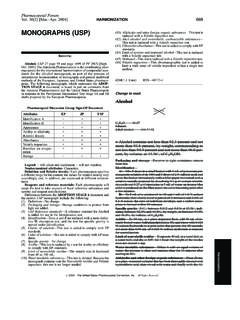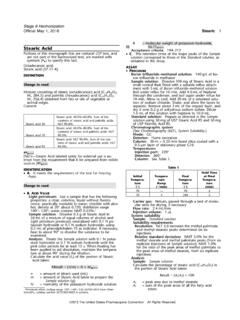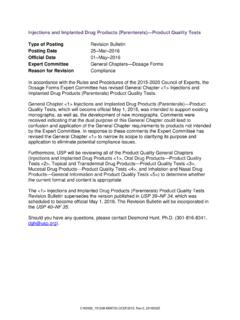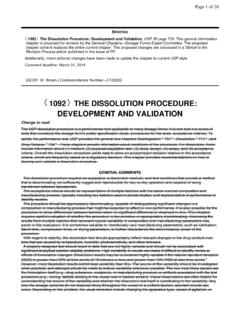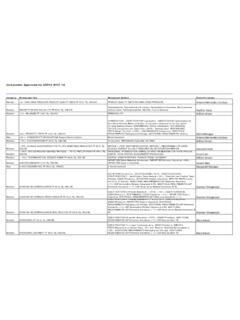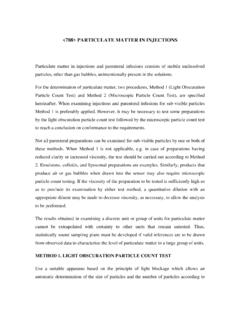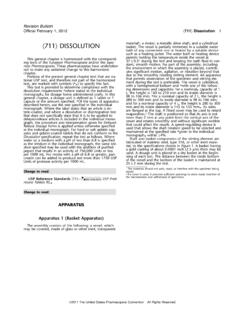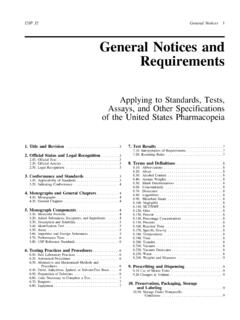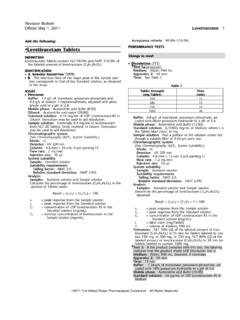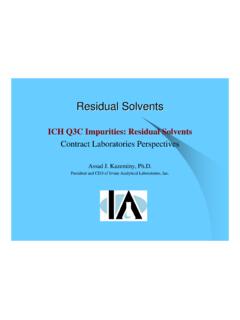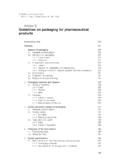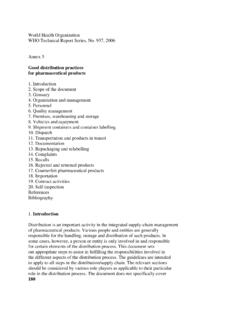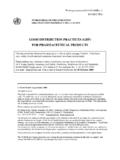Transcription of 659 Packaging and Storage Requirements, - USP-NF
1 BRIEFING. 659 Packaging and Storage Requirements, USP 42 page 6801 and PF 44(4) [July Aug. 2018]. The General Chapters Packaging and Distribution Expert Committee has canceled the PF 44(4) proposal and is now proposing the following revision. The purpose of the revisions will be to provide a delayed extension of the requirements specified in Plastic Materials of Construction and Plastic Packaging Systems for Pharmaceutical Use , which otherwise were to become applicable on May 1, 2020. through this chapter, to enable early adoption of the requirements in . and at any time during the implementation delay period in lieu of meeting the reinstated Plastic Packaging Systems and Their Materials of Construction 661 requirements. The specific revisions are as follows: 1. Delay until December 1, 2025 the implementation of the new requirements of and as currently specified in this chapter. 2. To make 661 , as referenced in this chapter, applicable until November 30, 2025.
2 3. In this chapter, clarify that early adoption of the requirements of and is permitted by USP, and that Packaging systems in compliance with these requirements in advance of December 1, 2025 will no longer need to comply with 661 requirements to be considered by USP to be in conformance with the USP NF. 4. For the "Small-volume injection" and "Large-volume injection". definitions, it was clarified that terms are also referred to as "Small- volume parenteral" and "Large-volume parenteral", respectively. Additionally, minor editorial changes have been made to update the chapter to current USP style. (GCPD: D. Hunt.). Correspondence Number C201835. 1 659 Packaging AND Storage REQUIREMENTS. 2 Change to read: 3 (A portion of the Associated Components section of this chapter will 4 become official on May 1, 2019, and a portion of the Packaging 5 section of this chapter will become official on May 1, 6 2020, December 1, 2025 (USP 1-Aug-2020) as indicated.)
3 Early adoption of 7 the requirements in this chapter and Plastic Materials of 8 Construction and Plastic Packaging Systems for 9 Pharmaceutical Use are permitted by USP.). 10 INTRODUCTION. 11 The purpose of this chapter is to provide Packaging definitions, auxiliary 12 Packaging information, and Storage condition definitions relevant to the 13 Storage and distribution of active ingredients, excipients, and medical 14 products, such as pharmaceuticals, devices, combination products ( , 15 drug-eluting stents), and dietary supplements. 16 Change to read: 17 Packaging . 18 Packaging materials must not interact physically or chemically with a 19 packaged article in a manner that causes its safety, identity, strength, 20 quality, or purity to fail to conform to established requirements. Any 21 plastic material used to construct a Packaging system must meet the 22 applicable requirements of Plastic Materials of Construction . 1- 23 May-2020 All Packaging systems must meet the applicable requirements specified in 24 Containers Glass 660 , Plastic Packaging Systems and Their Materials of 25 Construction 661 , Plastic Packaging Systems for Pharmaceutical Use 26 , 1-May-2020 and Auxiliary Packaging Components 670.
4 All elastomeric 27 closures must meet the applicable requirements in Elastomeric Closures 28 for Injections 381 . 29 Every monograph in USP NF must have Packaging and Storage 30 requirements. For the Packaging portion of the statement, the choice of 31 containers is provided in this chapter. For active pharmaceutical 32 ingredients (APIs), the choice would be a tight, well-closed, or, where 33 needed, light-resistant container. For excipients, given their typical 34 presentation as large-volume commodity items ( Packaging systems 35 ranging from drums to tank cars), a well-closed container is an appropriate 36 default requirement. Articles must be protected from moisture, freezing, 37 and excessive heat (see General Definitions) when no specific directions or 38 limitations are provided. 39 The compendial requirements for the use of specified containers apply also 40 to articles packaged by Dispensers, Repackagers, or other individuals, 41 unless otherwise indicated in the individual drug product monograph.
5 42 POISON PREVENTION Packaging ACT. 43 This act, which is administered by the United States Consumer Product 44 Safety Commission (CPSC), requires special Packaging for most human 45 oral prescription drugs, oral controlled drugs, certain non-oral prescription 46 drugs, certain dietary supplements, and many over-the-counter (OTC). 47 drug preparations, to protect the public from personal injury or illness 48 from misuse of these preparations [16 Code of Federal Regulations (CFR). 49 ]. 50 The primary Packaging of substances regulated under the Poison Prevention 51 Packaging Act (PPPA) must comply with the special Packaging standards 52 (16 CFR ). These apply to all Packaging types, including 53 reclosable, non-reclosable, and unit-dose types. 54 Special Packaging is not required for drugs dispensed within a hospital 55 setting for inpatient administration. Also, special Packaging does not need 56 to be used by manufacturers and packagers of bulk-packaged prescription 57 drugs that will be repackaged by the pharmacist.
6 PPPA-regulated 58 prescription drugs may be dispensed in non-Child-resistant Packaging 59 upon the request of the purchaser or when directed in a legitimate 60 prescription [15 United States Code (USC) 1473]. 61 Manufacturers or packagers of PPPA-regulated OTC preparations are allowed 62 to package one size in non-Child-resistant Packaging as long as popular- 63 size, special packages are also supplied. The non-Child-resistant Packaging 64 requires special labeling (16 CFR ). 65 TEMPERATURE AND Storage . 66 Specific directions are stated in some monographs with respect to Storage 67 conditions ( , the temperature or humidity) at which an article must be 68 stored and shipped. Such directions apply except where the label on the 69 article has different Storage conditions that are based on stability studies. 70 Where no specific directions or limitations are provided in the article's 71 labeling, articles must be protected from moisture, freezing, and excessive 72 heat, and, where necessary, from light during shipping and distribution.
7 73 Drug substances are exempt from this standard. 74 Change to read: 75 GENERAL DEFINITIONS. 76 Packaging Definitions 77 Packaging system (also referred to as a Container closure system): The 78 sum of Packaging components and materials that together contain and 79 protect the article. This includes primary Packaging components as well as 80 Secondary Packaging components when such components are required to 81 provide additional protection. 82 Container: A receptacle that holds an intermediate compound, API, 83 excipient, or dosage form, and is in direct contact with the article ( , 84 ampules, vials, bottles, syringes, and pen injectors). 85 Closure: A material that seals an otherwise open space of a Container and 86 provides protection for the contents. It also provides access to the contents 87 of the Container ( , screw caps and stoppers). 88 Packaging component: Any single part of the Package or Container . 89 closure system, including: the Container ( , ampules, syringes, vials, and 90 bottles); Closures ( , screw caps and stoppers); ferrules and overseals.
8 91 Closure liners ( , tube cartridge liners); inner seals; administration ports;. 92 overwraps; administration accessories; labels; cardboard boxes; and shrink 93 wrap. 94 primary Packaging component: A Packaging component that is in direct 95 contact with or may come into direct contact with the article. 96 Secondary Packaging component: A Packaging component that is in 97 direct contact with a primary Packaging component and may provide 98 additional protection for the article. 99 Tertiary Packaging component: A Packaging component that is in direct 100 contact with a Secondary Packaging component and may provide additional 101 protection for the article during transportation and/or Storage . 102 Ancillary component: A component or entity that may come into contact 103 with a Tertiary Packaging component during the distribution, Storage , and/or 104 transportation of the packaged article ( , pallets, skids, and shrink wrap). 105 Associated component: A Packaging component that is typically intended 106 to deliver the drug article to the patient but is not stored in contact with the 107 article for its entire shelf life ( , spoons, Dosing cups, and dosing 108 syringes).
9 109 Materials of construction: The materials ( , glass, plastic, elastomers, 110 and metal) of which a Packaging component consists. 111 Small-volume injection (also referred to as (USP 1-Aug-2020) Small-volume 112 parenteral): An injectable dosage form that is packaged in Containers 113 labeled as containing 100 mL or less. 114 Large-volume injection (also referred to as (USP 1-Aug-2020) Large-volume 115 parenteral): An injectable dosage form that is packaged in Containers 116 labeled as containing more than 100 mL. 117 Child-resistant Packaging : A Packaging system designed or constructed to 118 meet CPSC standards pertaining to opening by children (16 CFR et 119 seq. and 16 CFR ). 120 Senior-friendly Packaging : A Packaging system designed or constructed 121 to meet CPSC standards pertaining to opening by senior adults (16 CFR. 122 and 16 CFR ). 123 Restricted delivery system: A Packaging system designed or constructed 124 to restrict (control) the amount of the drug product that may be delivered in 125 order to limit unintended access by children and other similarly vulnerable 126 populations.
10 Restricted delivery systems should meet and may exceed CPSC. 127 standards for special Packaging [Child-resistant and Senior-friendly 128 Packaging (16 CFR et seq.)]. For oral medicinal liquids, surface 129 and flow characteristics vary. It is the responsibility of the manufacturer to 130 ensure that all components of the Restricted delivery system provide the 131 intended safety protection. One component of the Restricted delivery system 132 is the flow restrictor, which is a Packaging component that restricts the flow 133 of liquid. The flow restrictor may be used as part of a Restricted delivery 134 system or as an adaptor to facilitate use of a measuring device for oral 135 medicinal liquids. A flow restrictor should not compromise CPSC standards 136 for special Packaging [Child-resistant and Senior-friendly Packaging (16 CFR. 137 et seq.)]. 138 Tamper-evident Packaging : A Packaging system that may not be 139 accessed without obvious destruction of the seal or some portion of the 140 Packaging system.
